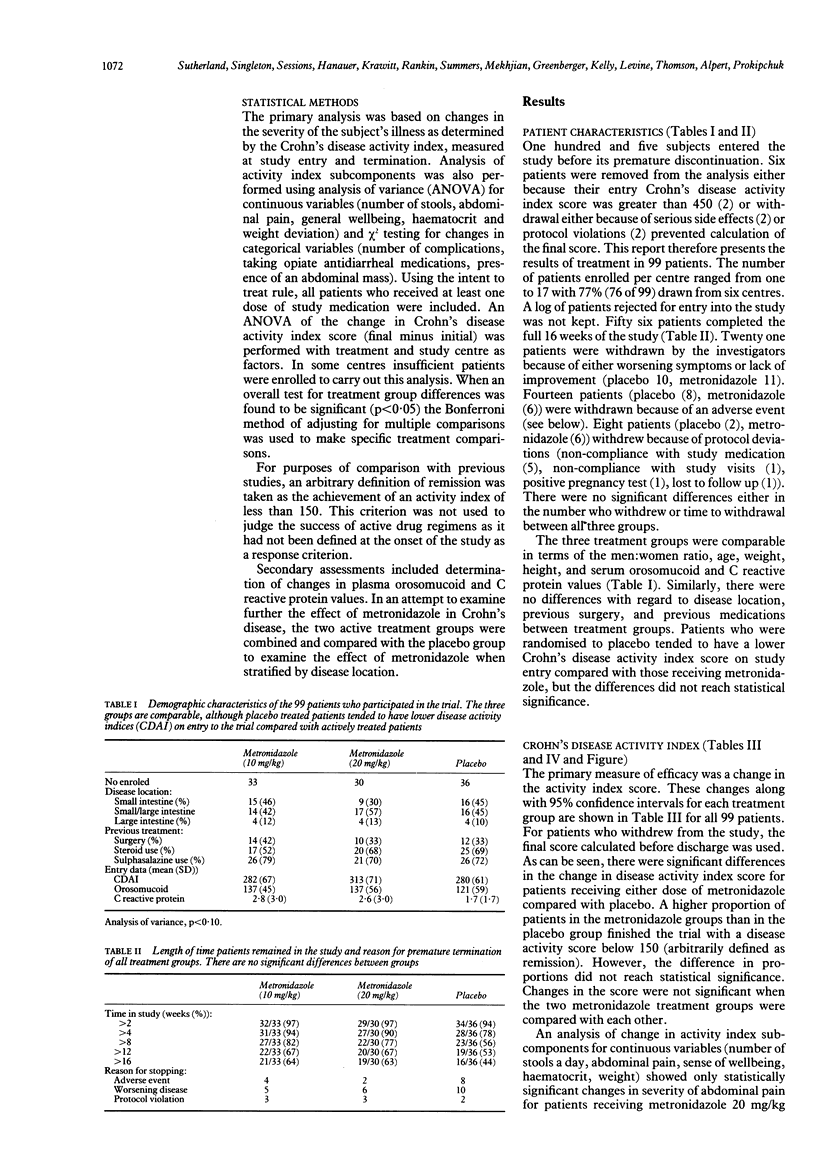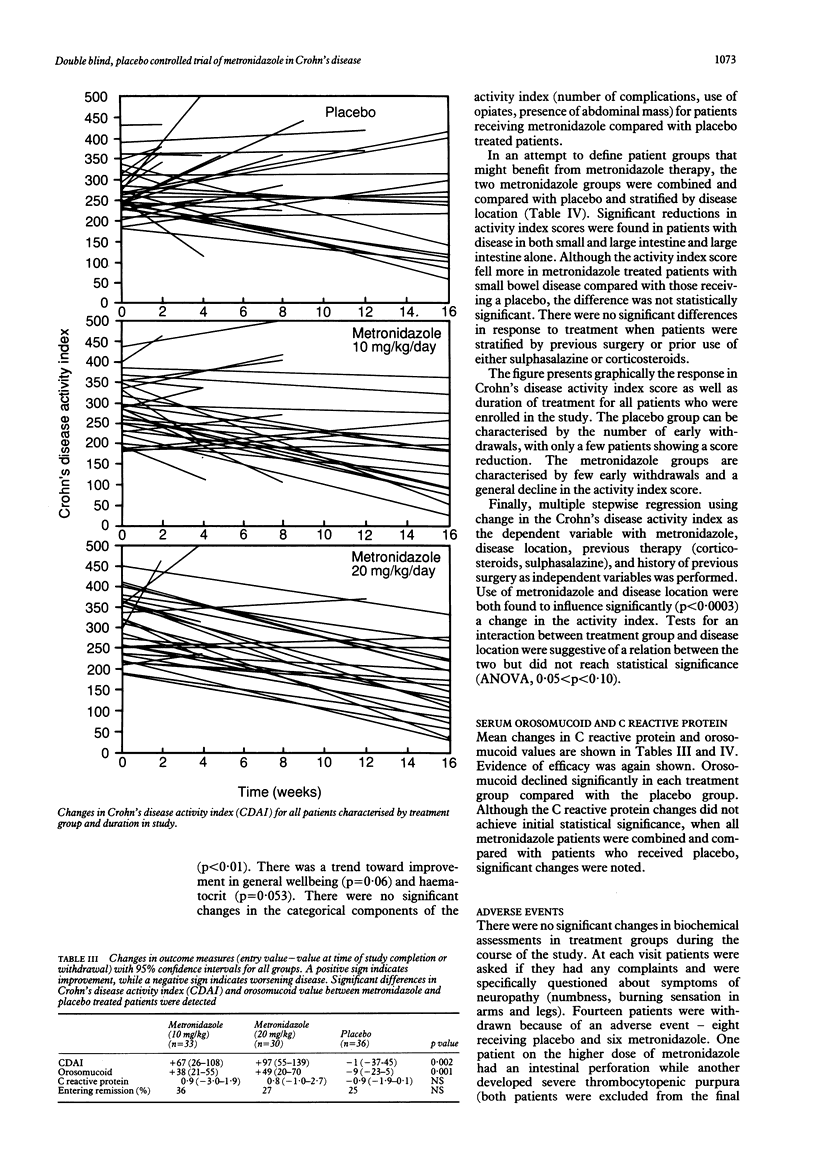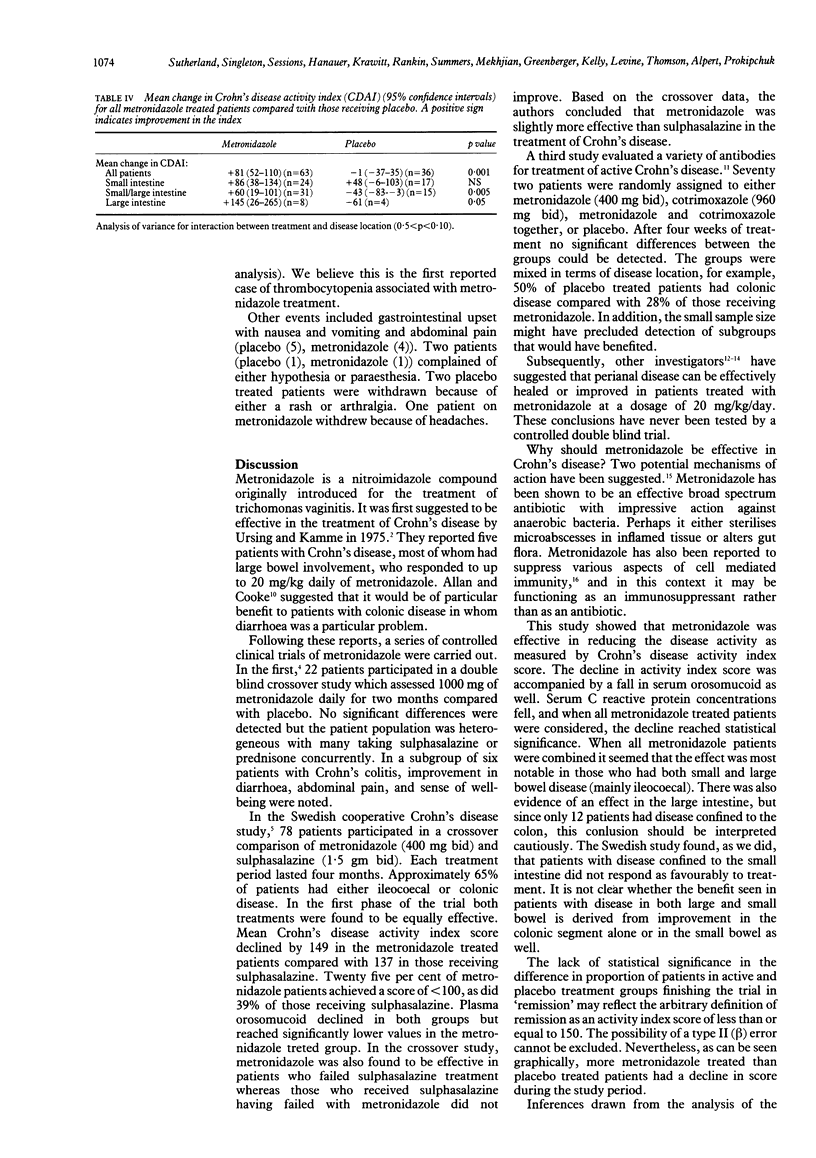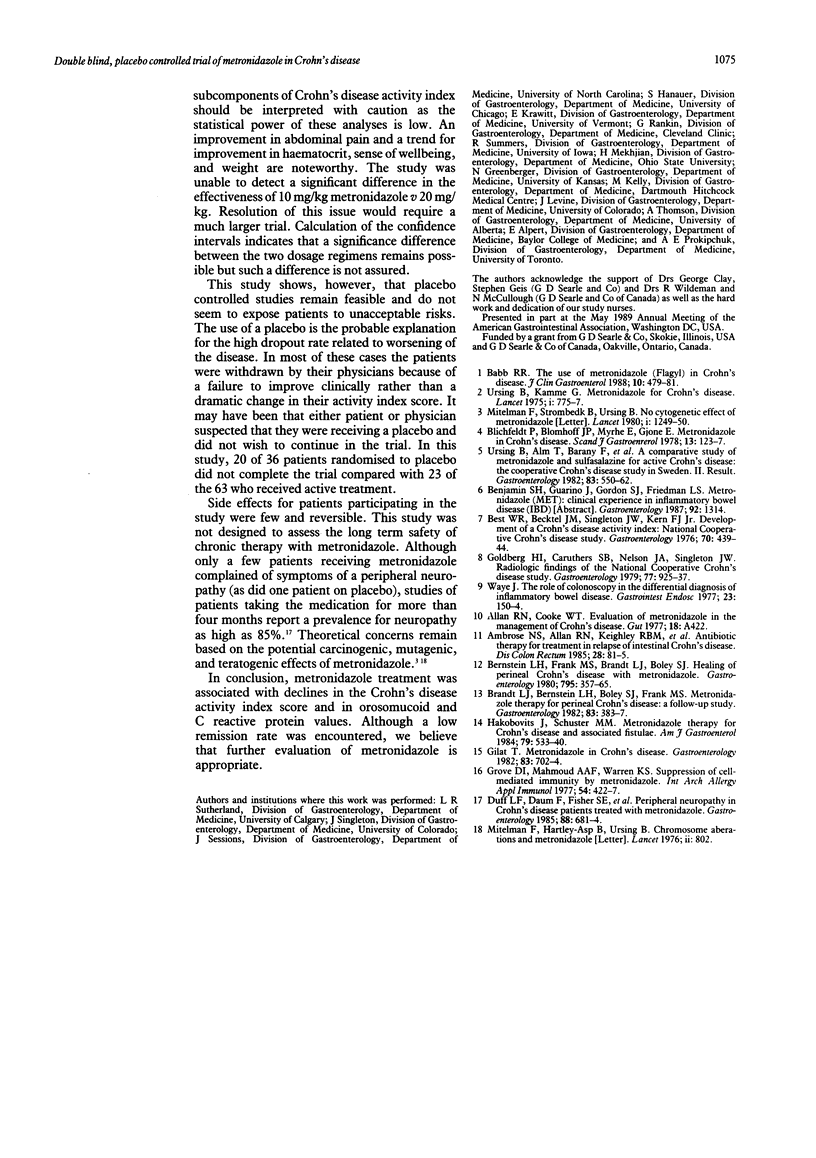Abstract
A double blind study compared the efficacy of metronidazole in two doses (20 mg/kg, 10 mg/kg) with placebo in patients with Crohn's disease. One hundred and five patients participated but only 56 completed the 16 week study -21 were withdrawn for deterioration of symptoms, 17 for adverse experiences, and 11 for protocol violation. Significant improvement in disease activity as measured by the Crohn's disease activity index (metronidazole 20 mg/kg, 97 units; metronidazole 10 mg/kg, 67 units; placebo -1 unit, p = 0.002) and serum orosomucoid (metronidazole 20 mg/kg/day, 49; 10 mg/kg/day, 38; placebo, -9, p = 0.001)) were detected. Changes in C reactive protein concentrations did not achieve significance when all three groups were considered but were significant when all metronidazole treated patients were grouped and compared with the placebo treated patients (0.8 v -0.9, p less than 0.05). Although patients receiving metronidazole 20 mg/kg/day had a greater improvement in disease activity than those receiving 10 mg/kg/day (difference 30 units (95% confidence intervals -27-87), the small sample size may have precluded the detection of statistical significance. Preliminary analysis suggests that metronidazole was more effective in patients with disease confined to the large intestine or affecting both small and large bowel than in those with small bowel disease only. There were no differences in remission rates between metronidazole and placebo treated patients. We conclude that metronidazole warrants further assessment in the treatment of patients with active Crohn's disease.
Full text
PDF




Selected References
These references are in PubMed. This may not be the complete list of references from this article.
- Ambrose N. S., Allan R. N., Keighley M. R., Burdon D. W., Youngs D., Barnes P., Lennard-Jones J. E. Antibiotic therapy for treatment in relapse of intestinal Crohn's disease. A prospective randomized study. Dis Colon Rectum. 1985 Feb;28(2):81–85. doi: 10.1007/BF02552649. [DOI] [PubMed] [Google Scholar]
- Babb R. R. The use of metronidazole (Flagyl) in Crohn's disease. J Clin Gastroenterol. 1988 Oct;10(5):479–481. doi: 10.1097/00004836-198810000-00002. [DOI] [PubMed] [Google Scholar]
- Bernstein L. H., Frank M. S., Brandt L. J., Boley S. J. Healing of perineal Crohn's disease with metronidazole. Gastroenterology. 1980 Aug;79(2):357–365. [PubMed] [Google Scholar]
- Best W. R., Becktel J. M., Singleton J. W., Kern F., Jr Development of a Crohn's disease activity index. National Cooperative Crohn's Disease Study. Gastroenterology. 1976 Mar;70(3):439–444. [PubMed] [Google Scholar]
- Blichfeldt P., Blomhoff J. P., Myhre E., Gjone E. Metronidazole in Crohn's disease. A double blind cross-over clinical trial. Scand J Gastroenterol. 1978;13(1):123–127. doi: 10.3109/00365527809179816. [DOI] [PubMed] [Google Scholar]
- Brandt L. J., Bernstein L. H., Boley S. J., Frank M. S. Metronidazole therapy for perineal Crohn's disease: a follow-up study. Gastroenterology. 1982 Aug;83(2):383–387. [PubMed] [Google Scholar]
- Gilat T. Metronidazole in Crohn's disease. Gastroenterology. 1982 Sep;83(3):702–704. [PubMed] [Google Scholar]
- Goldberg H. I., Caruthers S. B., Jr, Nelson J. A., Singleton J. W. Radiographic findings of the National Cooperative Crohn's Disease Study. Gastroenterology. 1979 Oct;77(4 Pt 2):925–937. [PubMed] [Google Scholar]
- Grove D. I., Mahmound A. A., Warren K. S. Suppression of cell-mediated immunity by metronidazole. Int Arch Allergy Appl Immunol. 1977;54(5):422–427. doi: 10.1159/000231857. [DOI] [PubMed] [Google Scholar]
- Jakobovits J., Schuster M. M. Metronidazole therapy for Crohn's disease and associated fistulae. Am J Gastroenterol. 1984 Jul;79(7):533–540. [PubMed] [Google Scholar]
- Mitelman F., Hartley-Asp B., Ursing B. Chromosome aberrations and metronidazole. Lancet. 1976 Oct 9;2(7989):802–802. doi: 10.1016/s0140-6736(76)90636-x. [DOI] [PubMed] [Google Scholar]
- Mitelman F., Strömbeck B., Ursing B. No cytogenic effect of metronidazole. Lancet. 1980 Jun 7;1(8180):1249–1250. doi: 10.1016/s0140-6736(80)91706-7. [DOI] [PubMed] [Google Scholar]
- Ursing B., Alm T., Bárány F., Bergelin I., Ganrot-Norlin K., Hoevels J., Huitfeldt B., Järnerot G., Krause U., Krook A. A comparative study of metronidazole and sulfasalazine for active Crohn's disease: the cooperative Crohn's disease study in Sweden. II. Result. Gastroenterology. 1982 Sep;83(3):550–562. [PubMed] [Google Scholar]
- Ursing B., Kamme C. Metronidazole for Crohn's disease. Lancet. 1975 Apr 5;1(7910):775–777. doi: 10.1016/s0140-6736(75)92438-1. [DOI] [PubMed] [Google Scholar]
- Waye J. D. The role of colonoscopy in the differential diagnosis of inflammatory bowel disease. Gastrointest Endosc. 1977 Feb;23(3):150–154. doi: 10.1016/s0016-5107(77)73622-3. [DOI] [PubMed] [Google Scholar]


